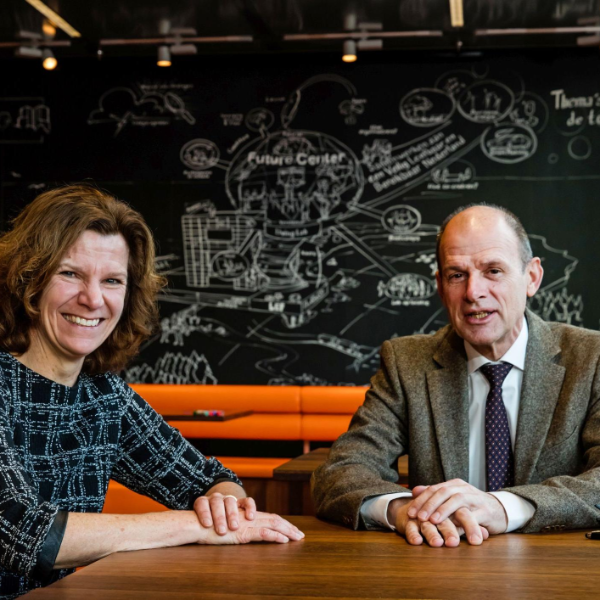Sustainable get-up-and-go

Sustainable get-up-and-go
Peter Struik has been serving the Directorate-General of Public Works and Water Management (Rijkswaterstaat, RWS) as chief engineer and director of its programme for sustainability and the living environment since 2017. His ambition is to turn RWS into the government’s most sustainability-focused executive organisation. However, this ambition does come with its fair share of challenges and dilemmas. Karin Sluis, Witteveen+Bos’s Managing Director, spoke to Peter Struik about this.
First of all, there is the ‘issue’ of comprehensiveness. Sustainable land use involves many policy areas: mobility, water, energy, spatial planning, the Environment Act and, of course, economic issues as well. Peter Struik: ‘Aiming for a sustainable living environment requires a shift from segmented thinking to acting in an integrated and sustainable manner. At RWS, we prefer to regard every assignment as area-specific by answering questions including: What functions and values does the area have? What connections are there? And what can be used for multiple functions? The central idea here is that the more comprehensive the question posed to us is, the more comprehensive the solution we can implement. But that does require a targeted effort. And even internally, RWS still does not always think in terms of functionality – the focus is often still on engineering.’ Karin Sluis recognises the dilemma: ‘Engineering agencies face the same sort of challenge. Sometimes RWS presents us with a question that we would have preferred to be just that little bit different. That’s why Witteveen+Bos is committed to applying seven sustainable design principles. These are part of our quality handbook and promote comprehensive thinking and having discussions along those lines with the client. Sometimes, an assignment is changed as a result. And what’s even better, in some cases these principles are the reason for awarding a contract to Witteveen+Bos.'
'Engineering agencies help to put matters such as energy neutral operation and circularity on the agenda'
- Peter Struik
Peter Struik: ‘We already share our concern for the problem, but no shared, joint solution has been identified yet. In other words: I am very happy about the intentions, but we really need to make some headway now. The operative word here is collaboration. And that leads up to the next dilemma. Sometimes, the rules and contracts imposed by RWS stand in the way of a comprehensive approach. Comprehensiveness requires a joint – chain-based – approach of drawing up an assignment. But how do you go about drawing up assignments and developing solutions using a chain-based approach involving competitors? Engineering agencies are still very hesitant about sharing knowledge.’ Karin Sluis: ‘A degree of competition is necessary to drive innovation. And working in a chain is sometimes difficult. But it is possible nonetheless. We did gain experience in chain-based collaboration with EcoShape (Building with Nature), a public-private partnership with RWS and other government bodies, knowledge institutes, engineering agencies and contractors.’
What would be more effective in our industry – disruptive and radical innovation or taking things forward step by step and gradually? Peter Struik: ‘The issues our industry is faced with, are its most challenging to date and include the energy transition, circular economy and the new Environment Act. However, the industry itself is moving quite slowly. It is time for an upgrade, by pursuing strategies that are smarter and more comprehensive, by connecting engineering and financial engineering, and by looking at new types of arrangements and different types of contracts involving multiple partners of all sorts and conditions. If you look at a programme like Smart Mobility 2030, it could very well get the fire going if things are made concrete in, for instance, the details of the government’s Multi-Year Programme for Infrastructure, Spatial Planning and Transport (MIRT). We need to invest in a joint vision, and work together on drawing up a comprehensive assignment that we can divide up into manageable parts. Once again, effective and open collaboration is key.
However, we do need to accelerate the realisation of our ambitions. For instance, the need to make the energy transition happen is widely accepted, but the immediate costs are often high. Although we are capable of achieving better solutions in the short term, we can’t afford them.’ Karin Sluis: ‘Sustainable investments could offer a solution there. Issues of this kind require a joint approach by not only RWS and the agencies but many more sectors in society. Entrepreneurship is not one of RWS’s core tasks, so that is where engineering agencies can extend a helping hand and close the chain. RWS and the agencies share the desire to change our part of the world for the better. It would be wonderful if different design principles aimed at sustainability and the living environment could be compared and be used as the basis for developing a code of conduct for engineers. That would give us the sustainable get-up-and-go we need. Witteveen+Bos’ seven sustainable design principles are a solid foundation for the further development of joint principles.’